► Fastest Lotus production car ever
► Two versions: Sport is minus the wing
► 60 of each to be built, from £104,500
You’re looking at the fastest Lotus road car ever – and the most expensive.
Just when it seemed Hethel’s engineers had squeezed the last drop of potential from the Evora with the relaunched Evora 400 and the hardcore Evora Sport 410, they’ve gone and made it even faster, by using a little know-how gained by successful forays into GT racing.
The new Lotus Evora GT430 is about as close as you can get to buying a GT racing car for the road. It uses the same suspension as that found on the Evora previously raced by Lotus engineer Gavan Kershaw in the GT4 class of the British GT championship, along with a brand-new aero kit delivering serious downforce, giant brakes and a race-developed five-stage traction control system, among other expensive goodies.
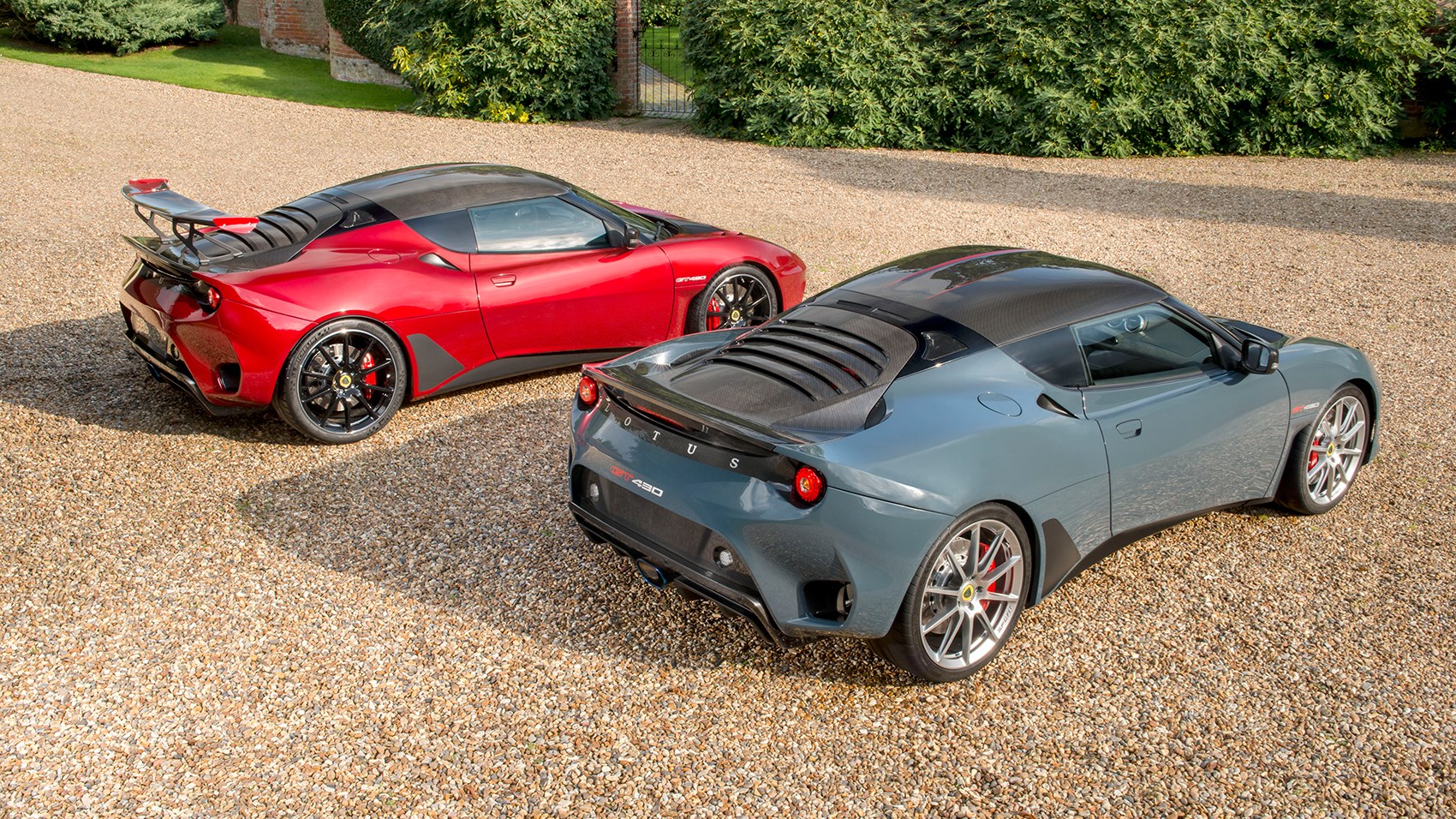
It’s available in two versions: the GT430 (the red car in the gallery, complete with giant rear wing), and the GT430 Sport (the grey car, without it). Only 60 of each will be built for sale across the world, although there’ll be a subsequent further production run made to meet regulations in the USA, in similarly limited numbers.
What’s the difference between the Lotus Evora GT430 and the GT430 Sport?
The GT430 Sport is the more demure, understated variant – thanks in no small part to the deletion of the skyscraping rear wing and tarmac-shadowing front splitter. It also gets slightly lighter, narrower wheels and tyres as standard – but they can be substituted for the GT430’s fatter footwear as an option.
What separates the new Lotus Evora GT430 from the Evora 400/Sport 410?
Quite a bit of cash – which we’ll come on to in a moment – but also some quite serious componentry. There are some really nice bits on these cars.
Some new bodywork is the most visible change, with redesigned bumpers front and rear, entirely in carbon fibre. Their new ducts guide and cajole the airflow to create downforce, and the Evora’s front numberplate has also been moved to speed up the airflow through the bumper. Outlets above and aft of the front wheels create low pressure zones to further accelerate airflow.
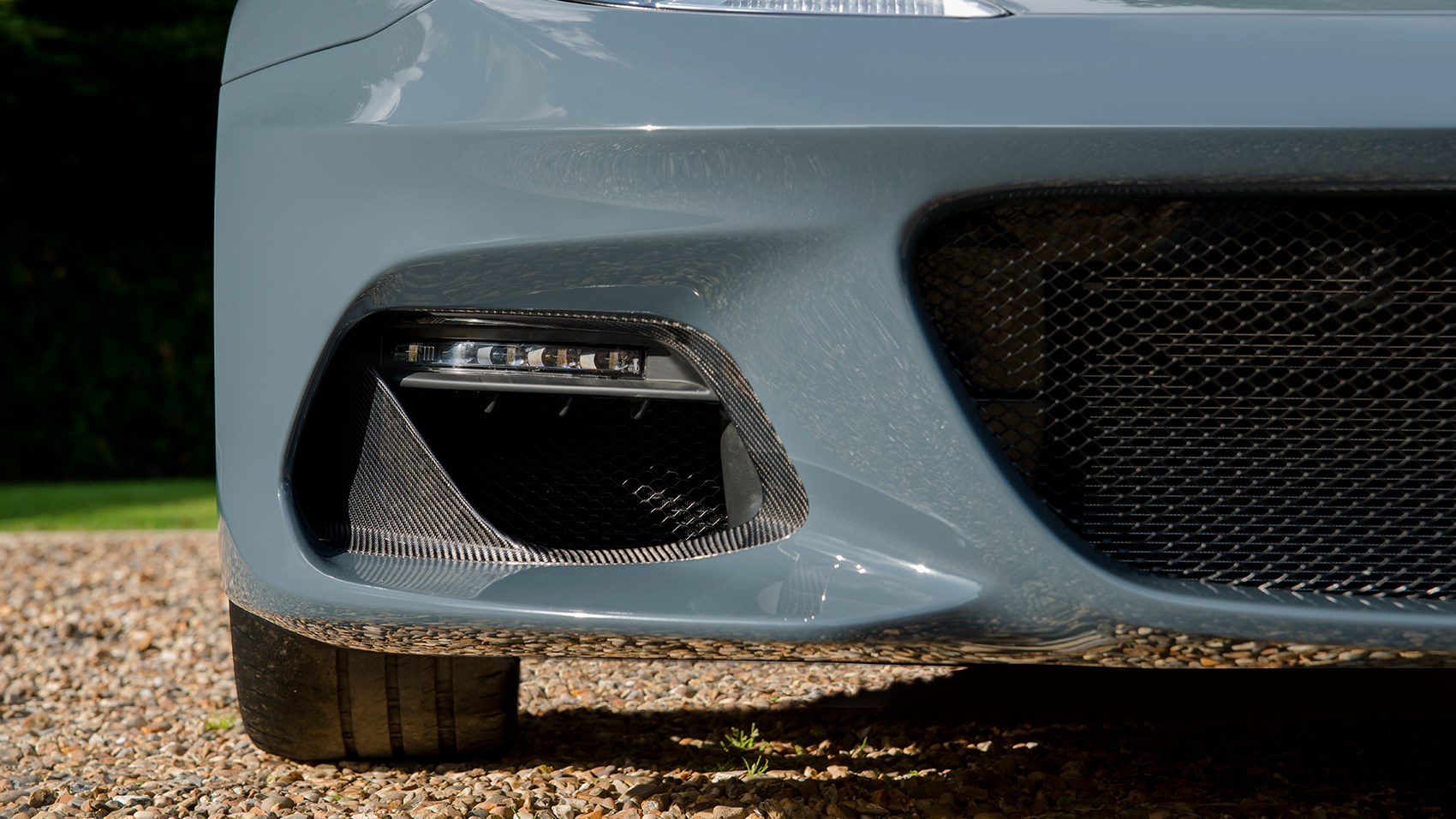
As a result, the Evora GT430 develops the highest downforce of any production Lotus yet – more than the Type 72 F1 car, in fact, with 250kg downforce at 190mph.
Without the wing, the GT430 Sport develops 100kg of downforce, and can hit 196mph. Yep, from the Evora’s 162mph beginnings in 2009, it’s now close to the magic 200mph. Some more serious stats: the Evora GT430 can get from 0 to 60mph in 3.6sec, and 0 to 100mph in less than eight.
Those downforce figures are impressive. For context, the majority of production cars develop lift at high speed, while the Evora Sport 410 develops 64kg of negative lift –downforce – at top speed, and the Evora 400 32kg.
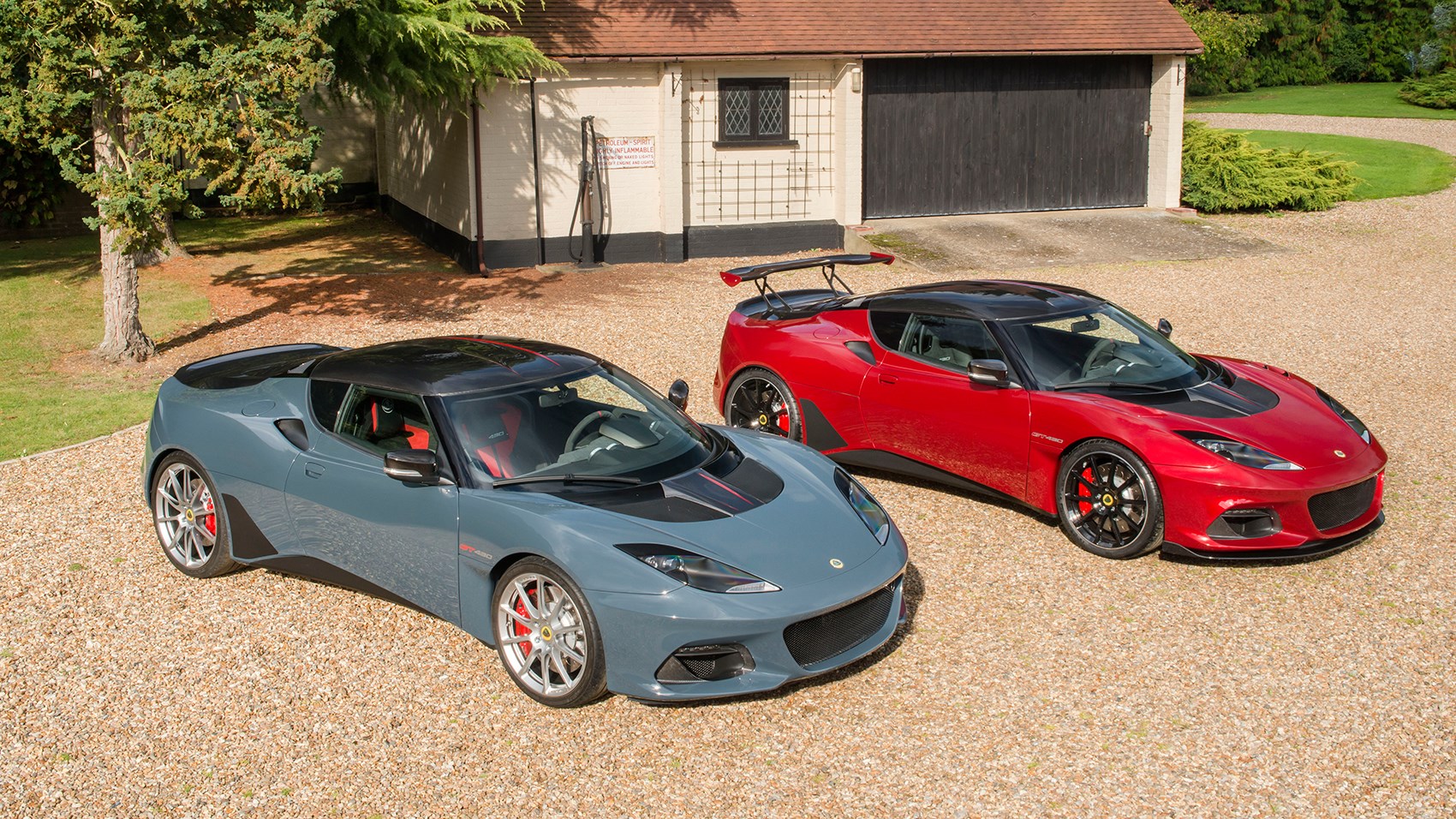
A 190mph+ top speed also puts the Evora right in the supercar league – but it also now carries a supercar-worthy price. The Evora GT430 Sport costs £104,500 before options, and the Evora GT430 costs £112,500.
At the time of writing the base Evora 400 costs £74,100 and the Evora Sport 410 £82,600.
What justifies the extra cost? Apart from all the carbonfibre, and the rarity value?
Well there really is a lot of carbonfibre, inside and out, but there’s also more power, race-spec suspension, clever electronics, some serious weight saving measures, new wheels, brakes and the widest tyres that could physically fit, among other goodies.
As you’ve probably guessed from the name, the GT430 now develops 430bhp at 7000rpm, making it the most powerful production Lotus yet. In the right spec, that gives the GT430 a healthy 345hp per tonne. The power hike comes primarily from recalibrated ignition, fuelling map and cam timing, as well as a standard titanium exhaust system, which sounds quite bewitching when its lungs open fully above 4500rpm or so.
There’s also a baffled sump, as per the GT4 racing car, to cope with the heightened cornering forces – bearing in mind Gavan Kershaw can get the GT430 to corner at 1.5g at Lotus’s Hethel test circuit…
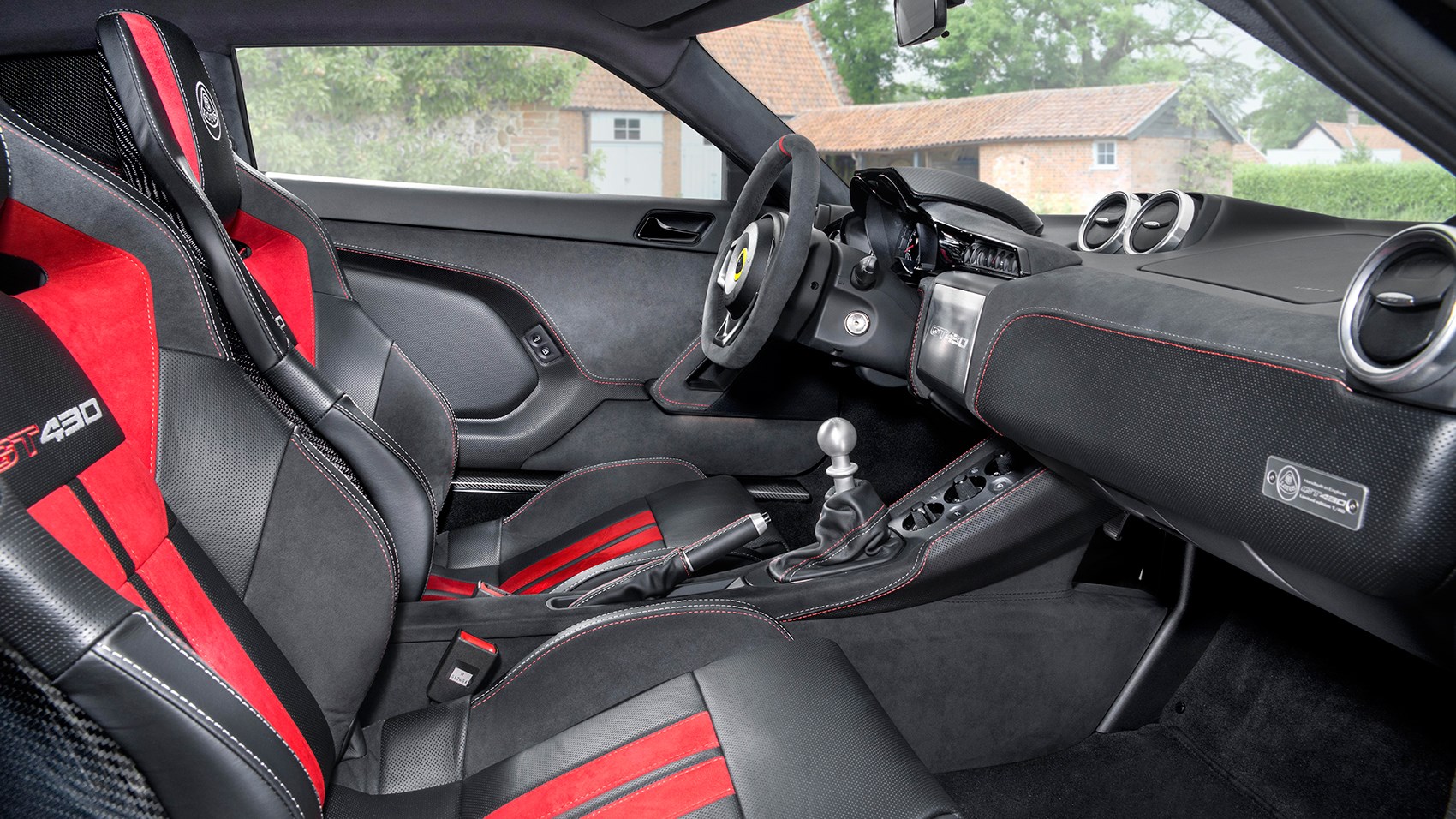
The six-speed manual gearbox is unchanged from the Evora 400/410 – and there’s still an auto option, believe it or not.
When Lotus relaunched the Evora as the Evora 400 in 2015 it went on a pretty serious diet, with each and every component being examined to see where weight could be saved. Which makes the fact that the GT430 weighs a whole 106kg less all the more remarkable. It’s also 36kg lighter than the stripped-out Evora Sport 410. Dry weight is 1248kg for the Sport, or 1258kg with the wing and the wider tyres.
Those lost kilos come courtesy of the titanium exhaust, carbon body panels and interior bits, polycarbonate in place of the rear glass, and some serious new suspension.
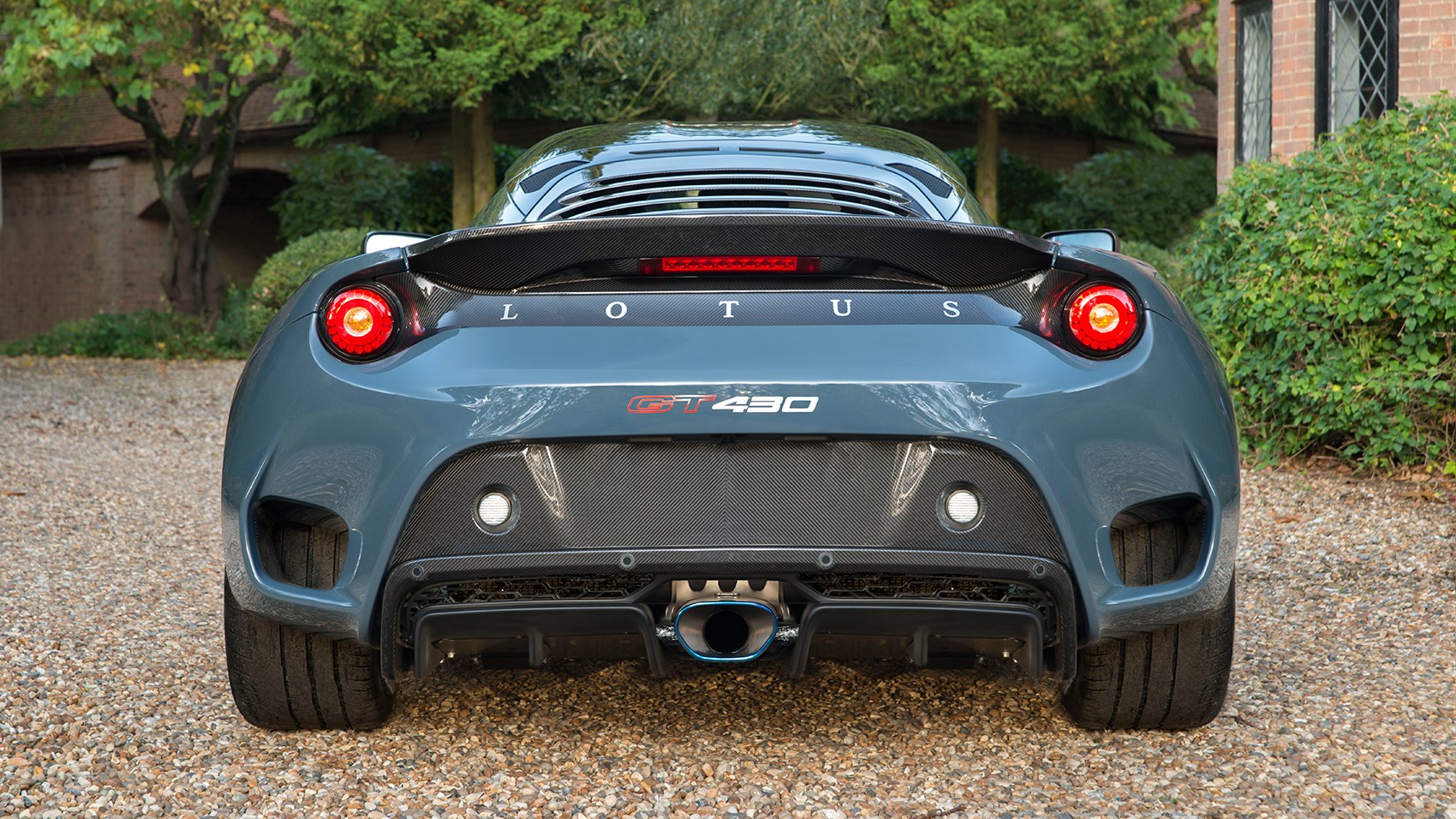
The GT430’s Ohlins and Eibach springs and dampers are fully adjustable, and save 10kg. Lotus was also keen to remove weight from beyond the axles to reduce the polar moment of inertia, so much so that they’ve even chopped 2.5kg from the washer bottle’s capacity.
Some of the weight saved has been put back on, by an enormously fat set of tyres. ‘These are the widest rear tyres we could physically fit to the Evora,’ Lotus CEO Jean-Marc Gales says. ‘We’re right on the limit of what is possible.’
The rear boots measure 295/30, and they’re all the more visible thanks to the new pressure-relieving cutouts in the rear bumper. The 430 Sport gets slightly narrower 285/30s, but is available with the fatter tyres as an option. The tyres themselves are Michelin Pilot Sport Cup 2s, of the same N0 type fitted to the Porsche 911 GT3 RS – probably the car closest in ethos to the GT430.
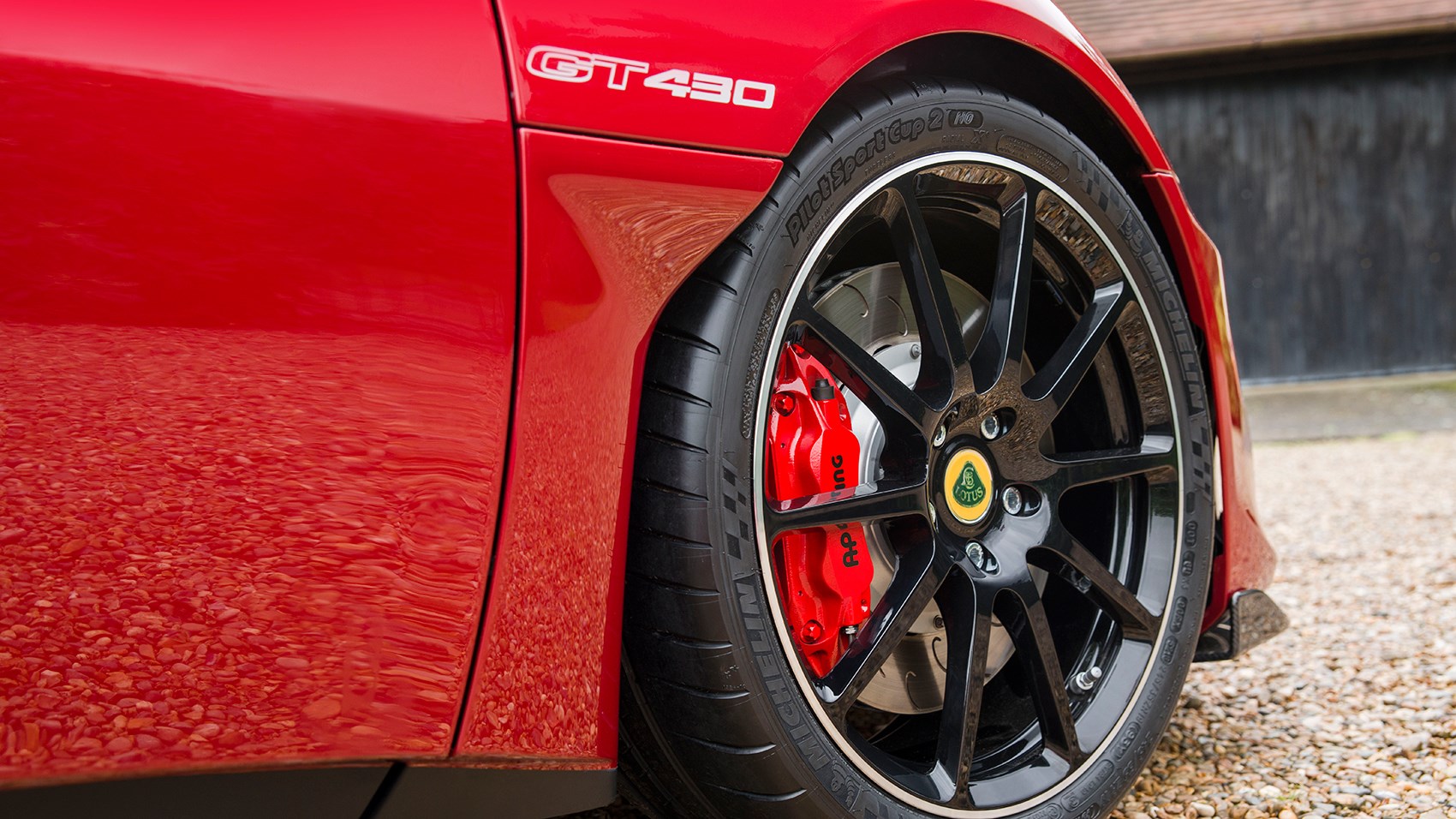
Also unique to the GT430 are brand-new AP Racing brakes, with enormous 370mm ‘J-hook’ pattern discs at the front, and 350mm at the rear, with four-pot calipers all round.
They sit inside a new set of super-light wheels with 10 skinny forged aluminium spokes, 19-inch at the front and 20 at the rear.
How much faster is the Lotus Evora GT430 than a regular Evora 400 or Sport 410?
It’s the fastest ever Lotus production car around the company’s Hethel test circuit – quicker even than the road-spec 3-Eleven.
The GT430 has recorded a 1m25.8sec lap, and to put that in context, the 3-Eleven road car and Exige Cup 380 both recorded 1m26sec dead.
More to the point, the base Lotus Evora 400 gets round Hethel in 1m30.8sec – and we know from experience that is a flipping quick car.
What’s the Lotus Evora GT430 like to drive on the track?
However fast a driver you are, however high your limits, this car is probably faster than you are. It’s almost like driving a full GT4-spec racing car – because that’s almost what it is.
There’s more dive under braking that you’d find in a racing car, but that could easily be tuned out with the adjustable suspension. The car’s standard baseline setup gives a safe understeer safety net to lean on if you get carried away, but likewise, you could make it as nervous and twitchy as you like by tinkering if you wished.
Those giant rear tyres really do take some unsticking. The lateral forces the GT430 can achieve through the fast sweepers at Lotus’s Hethel test circuit are quite something, and its suspension handles the kerbs well while the car is loaded too, with enough suppleness to avoid it being thrown off line.
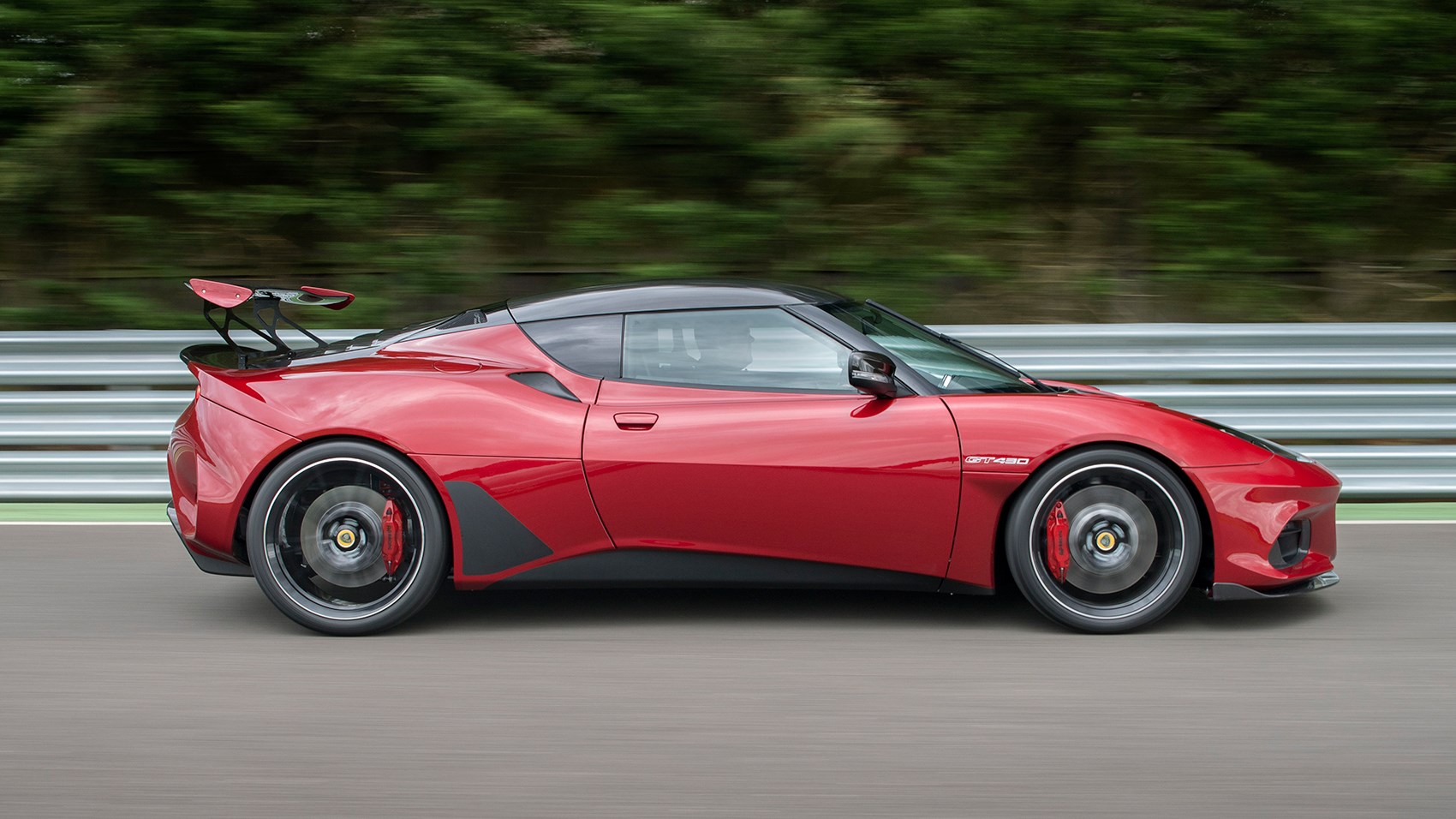
Lotus has fitted the GT430 with a race-developed five-stage traction control system. Like the regular Evora 400 and 410 there are typical Sport and Race modes, then once you’ve switched off the stability control there are five levels of traction control to choose from, acting on the ignition to cut the spark. Level five allows as much as 12% slip – a big slide, essentially – before it’ll get involved. I went up to level four, and in the dry there’s so much traction and mechanical grip (and aerodynamic grip), you’d really have to be quite brutal to get it to activate at all – you can flatten the throttle early out of slow corners with very little perceptible intervention from the TC.
It has race car stamina, too. The brakes don’t fade, the tyres don’t overheat, and it can go round after round like the toughest of boxers. Those big new brakes are as powerful as they look, stopping the car like you’ve driven into a wall.
Bad points – the manual gearchange is still tricky. It’s less recalcitrant than Evoras of old, but still demands patience, and you’re best to employ the one-pause-two school of careful gearshifting until you’re fully tuned into it.
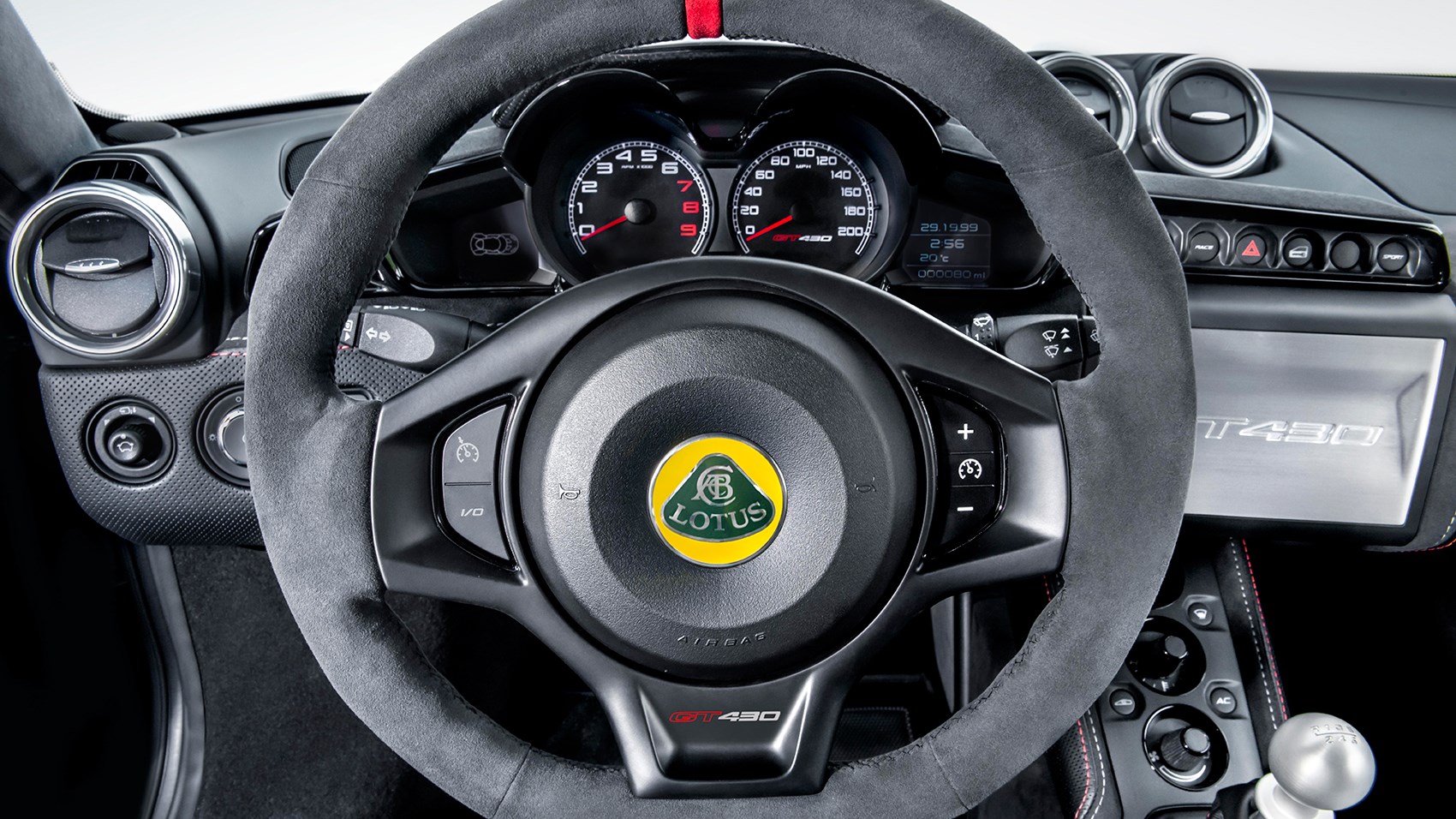
I’m also a bit narrow for the GT430’s race-derived, road-trimmed carbon seats (which weigh only 6kg each!) and could do with a multi-point harness rather than the standard conventional seatbelt to avoid sliding around within the seat on track. Lotus looked at offering a race harness as an option, but couldn’t due to regulations – the GT430 is a fully type-approved production car, not an IVA special – however dealers may offer them as a retrofit option.
In Lotus’s own words, ‘this a ‘momentum car’, providing effortless driving flow as speed builds’ – that it is, but you’ll be carrying a hell of a lot of momentum if you can get on top of it. This car’s limits are higher than those of the majority of drivers.
And what’s it like on the road?
We tried the GT430 on the track and the GT430 Sport on the road. Both had identical suspension settings. You can feel the extra firmness over the Evora 410, especially on dual carriageways – the GT430 has an enormous 47% increase in spring rates at the front and 20% at the rear – but to the car’s credit, it’s still supple and works with, rather than against, bumpier B-roads. It’s firm, but it still flows. The well-calibrated power steering is as communicative as ever, too.
There’s a fair bit of road noise, owing to the deleted sound deadening and giant tyres, but let the revs climb past 4500rpm or so and you won’t hear it, because the supercharged V6 plugged into the titanium exhaust will drown it out. Take my word for it, this is one of the best sounding production cars on sale today.
As with the Evora Sport 410, there’s nowhere to put anything in the interior apart from inside the glovebox, and there’s nowhere to rest your elbow as most of the door inners have been taken out to save weight.

Air-con is an extra-cost option, and so is a radio. Spec the latter and you get an newly upgraded version of the aftermarket-spec sat-nav touchscreen available in the rest of the Evora range, now with Apple CarPlay. It’s straightforward to use and works well enough.
You can choose how the interior’s trimmed – leather or alcantara, and in the GT430 there’s a smattering of lightweight carbon components, such as the shroud for the instruments and the sill covers. You can also substitute the track-spec buckets for comfier adjustable Sparco seats – I’m the wrong shape for these too, always feeling like I’m slouching, with the majority of the cushioning concentrated under the driver’s lower back – but they’re undoubtedly comfier over longer journeys.
You could conceivably specify a GT430 with the +2 rear seat option – but think of all the extra weight child seats would add, and how the raised c of g would play havoc with your lap time…
Verdict
This is a very serious car for serious money. The six-figure price tag is justified, at least to some extent, by the undoubtedly expensive componentry, and the GT430’s rarity value. A toy like this – and it’s the best kind of toy – isn’t a rational purchase anyway. If this kind of car is your cup of tea, the GT430 is a particularly tasty blend.